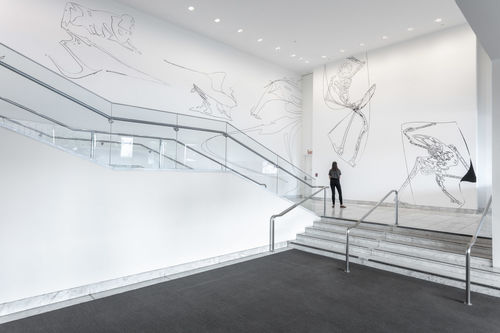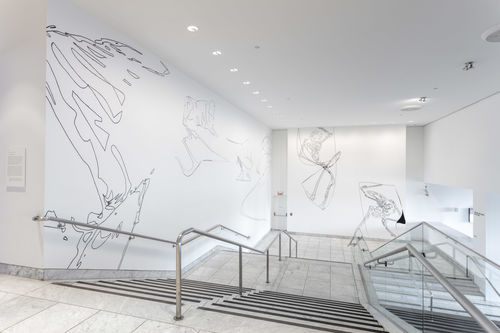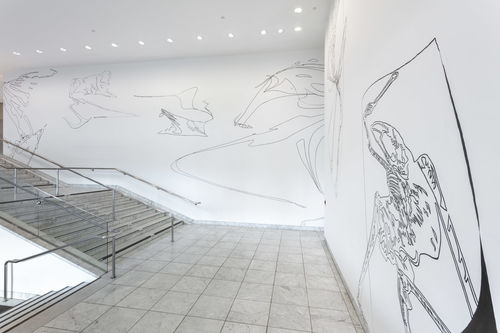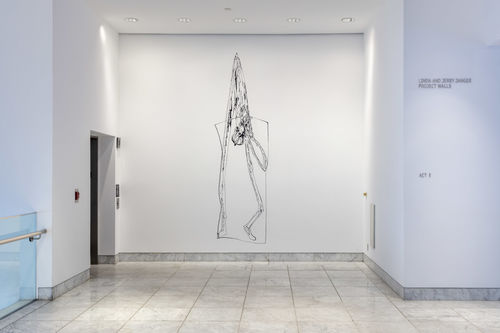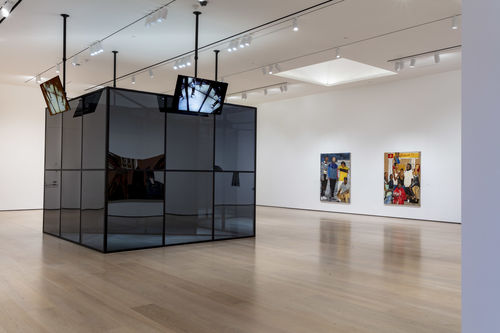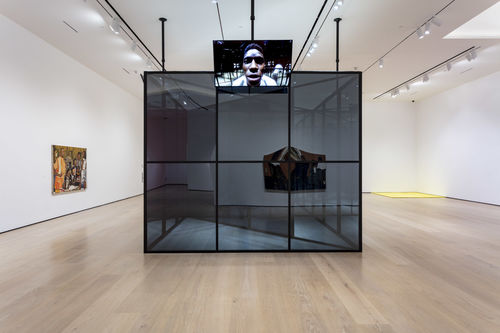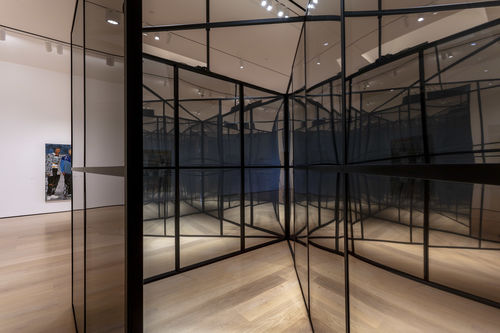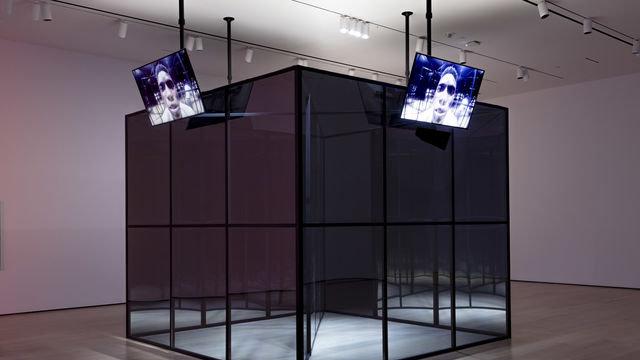
Aria Dean
Born in Los Angeles and raised by parents working in the entertainment industry, the artist, writer, and curator Aria Dean questions the structures of collective and individual subjectivities, with a focus on deconstructing and reconfiguring their relationship to networks of visibility, representation, and power. Often taking Blackness as a starting point and borrowing from the formal languages of minimalist sculpture and structural/materialist film (film that values the demystification of the filmmaking process as an attempt to showcase the “real event” of filming as closely as possible), Dean grapples with traditional histories and investigates the potential of other narratives attuned to material, political, and technological realities.
Aria Dean’s King of the Loop is a simulation staged inside a partially reflective mirrored box, which features a single actor, Edem Dela-Seshie, outfitted with a bodycam who is captured by a network of cameras stationed throughout the architecture of the set. The performance, a television play of sorts, examines the relationship between live event, broadcast, and documentation while also reflecting on formal, technical conventions and mechanics of theater, cinema, and web-based video–specifically the relationship between real time and the time of filmic montage. Though originally conceived as a live, four-person theatrical experience and broadcast, due to COVID-19, King of the Loop was prerecorded in the galleries in the weeks preceding the opening of Made in L.A 2020. The set remains intact, bearing the traces of performance, while the television play is shown on the screens above. In the performance, a man finds himself on an abandoned plantation, in a metaphysical knot. King of the Loop ricochets between a variety of genres and literary forms— including epic poetry, epistle, soliloquy, social realist theater, absurdism, and stand-up comedy—and draws on southern and European gothic storytelling traditions as well as science fiction.
On the Hammer's Wilshire Lobby wall, Aria Dean’s Les Simulachres is a collection of skeleton renderings drawn from fifteenth- and sixteenth-century danse macabre (dance of death) woodcuts, digitally manipulated to appear in various stages of abstraction. While the original images detail Death’s final visitation upon various members of European society, the figures reworked by Dean annotate her production King of the Loop, which, like the woodcuts, includes Death as an embodied character. These figures also operate as early instances of image piracy culture, with various artists and craftsmen throughout Europe producing their own versions after Hans Holbein’s series of woodcuts from 1538.
Additional support for Aria Dean's King of the Loop is provided by Pioneer Works.
In Made in L.A. 2020: a version, the artist’s work is present in two institutions, across Los Angeles. See Aria Dean's work on view at The Huntington.
BIOGRAPHY
Aria Dean was born in 1993 in Los Angeles. After obtaining a bachelor’s degree in studio art at Oberlin College, Dean returned to Los Angeles, taking a position as a social media strategist for the Museum of Contemporary Art. In many respects Dean’s early engagement in the digital sphere of an institution prefigured the questions she posed around Blackness within the emergent internet culture. She has examined the generative and gratuitous workings of online cultural production, from how the circulation of memes maps onto Blackness to the tepid visibility politics of selfies. Many of these ideas find form in Dean’s writing for publications such as Real Life Magazine, Texte zur Kunst, e-flux, Artforum, and Art in America, to name a few. Her eventual appointment as assistant curator of net art and digital culture at Rhizome underscored the renewed interest in art made for the internet. The kernel in all this is Dean’s artistic practice, which serves as the impetus for her writing and curating, the two activities offering prescriptive signposts that order how she makes objects in the service of the abovementioned ideas. The way she grapples with these ideas in visual form becomes a material experiment in the repetitive structure within Black cultural forms that welcomes variability. Dean has shown her works in solo and group exhibitions at Metropolitan Art Centre (MAC), Belfast, Ireland (2019); Institute for Contemporary Art at Virginia Commonwealth University, Richmond (2019); Het Hem, Amsterdam (2019); Institute of Contemporary Art, Philadelphia (2019); Albright-Knox Art Gallery, Buffalo (2018); Schinkel Pavillon, Berlin (2018); and The Sunroom, Richmond, Virginia (2017), among others. She has presented performance works at Swiss Institute, New York (2018), and Centre d’Art Contemporain, Geneva (2019).



